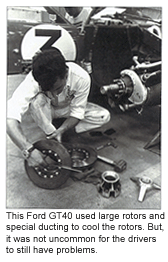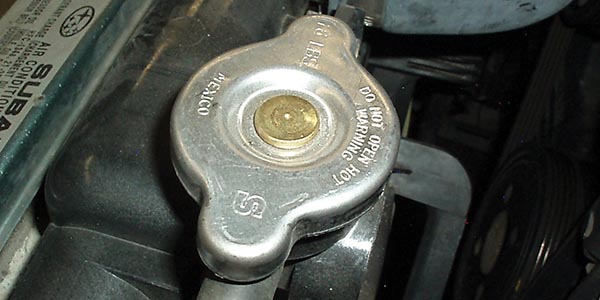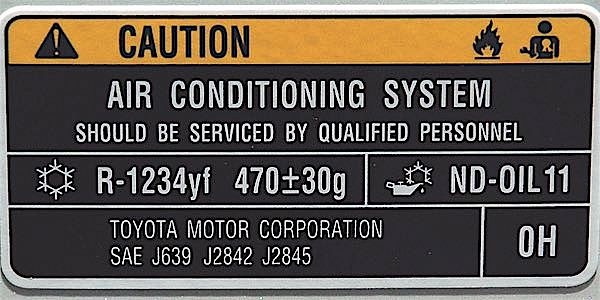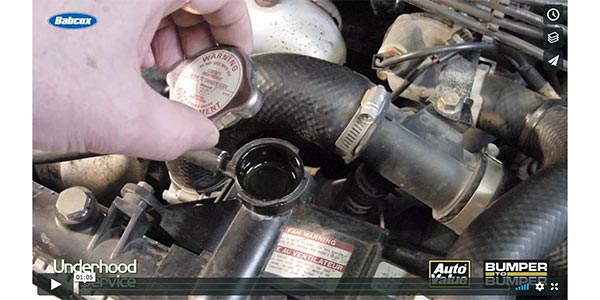Anybody who works on brakes knows what brake rotors do. They provide a friction surface for the disc brake pads to rub against when the brakes are applied. The friction created by the pads rubbing against the rotor generates heat and brings the vehicle to a stop. Big rotors can obviously handle more heat than small rotors. But many cars today have downsized rotors to reduce weight. Consequently, the brakes run hotter and require better rotor cooling to keep brake temperatures within safe limits.
 Anybody who works on brakes for a living knows that rotors can cause a lot of brake problems. Uneven rotor wear (which may be due to excessive rotor runout or rotor distortion) often produces variations in thickness that can be felt as pedal pulsations when the brakes are applied. The condition usually worsens as the rotors continue to wear, eventually requiring the rotors to be resurfaced or replaced.
Anybody who works on brakes for a living knows that rotors can cause a lot of brake problems. Uneven rotor wear (which may be due to excessive rotor runout or rotor distortion) often produces variations in thickness that can be felt as pedal pulsations when the brakes are applied. The condition usually worsens as the rotors continue to wear, eventually requiring the rotors to be resurfaced or replaced.
Rotors can also develop hard spots that contribute to pedal pulsations and variations in thickness. Hard spots may be the result of poor quality castings or from excessive heat that causes changes in the metallurgy of the rotors. A sticky caliper or dragging brake may make the rotor run hot and increase the risk of hard spots forming. Hard spots can often be seen as discolored patches on the face of the rotor. Resurfacing the rotor is only a temporary fix because the hard spot usually extends well below the surface and usually returns as a pedal pulsation within a few thousand miles. That’s why most brake experts replace rotors that have developed hard spots.
Cracks are another concern with rotors. Cracks can form as a result of poor metallurgy in the rotor (too hard and too brittle because the rotor was allowed to cool too quickly during the casting process), and from excessive heat. Some minor surface cracking is tolerable and can often be removed by resurfacing, but large cracks or deep cracks weaken the rotor and increase the risk of catastrophic failure. So cracked rotors should always be replaced.
METALLURGY
The metallurgical properties of a rotor determines its strength, noise, wear and braking characteristics. The casting process must be carefully controlled to produce a high quality rotor. You can’t just dump molten iron into a mold and hope for the best. The rate at which the iron cools in the mold must be closely monitored to achieve the correct tensile strength, hardness and microstructure.
If the iron cools too quickly, the particles of graphite don’t have as much time to form and are much smaller in size, which makes for a noisy rotor.
The rate of cooling also affects the hardness of a rotor. If a rotor is too hard, it will increase pad wear and noise. Hard rotors are also more likely to crack from thermal stress. If a rotor is too soft, it will wear too quickly and may wear unevenly increasing the risk of pedal pulsation and runout problems.
The grade of cast iron that’s used in a rotor may even be changed to suit a particular application. One aftermarket rotor manufacturer uses a special grade of “dampened iron” to make replacement rotors for 1997-2002 Chevrolet Malibu and its sister vehicles (Olds Alero, Olds CUtlass and Pontiac Grand Am). In this case, the original OEM rotors turned out to be too noisy so General Motors switched to a dampened grade of iron to cure the problem.
COOLING RIBS
Vehicle manufacturers use a wide variety of different cooling rib configurations in their rotors. They do this to optimize cooling for different vehicle applications. So even though the brakes may appear to be identical on two different models, one may require increased cooling because the vehicle is heavier, has a more powerful engine, has less airflow around the brakes, etc.
Some aftermarket rotor manufacturers use the same rib design and configuration as the OEM rotors, while others do not. Some change the rib design to simplify the casting process or to reduce the number of different rotor SKUs in their product lines.
The OEMs currently use almost 70 different rib configurations in their rotors. Some ribs are straight, some are curved and some are even segmented. Some rotors are directional and some are not. Some rotors have evenly spaced ribs while others do not. Some ribs radiate outward from the center and others go every which way.
One reason why they use so many different rib patterns is to maximize cooling and to reduce harmonics that contribute to brake squeal. Changing the rib design changes the airflow, cooling and noise characteristics of the rotor – which may make things better or worse depending on the application. That’s why some aftermarket rotor manufacturers use the same basic design as the original, while others stick with more traditional venting.
HEAT DAM
A heat dam is often machined into the area between the friction surface and hat on most rotors. The dam is a thinner section of metal that reduces heat transfer from the rotor surface to the hat. This protects the wheel hub and bearings from the heat and also allows the rotor to flex when it gets hot to reduce the risk of warping and cracking. If a rotor manufacturer cuts corners and eliminates the heat dam, heat can travel more easily to the hub and wheel bearings and increase the risk of bearing failure. The rotor may also be more prone to cracking under high heat conditions.
SURFACE FINISH
We’ll finish up with a few comments about surface finish. Smoother is always better because it affects the coefficient of friction, noise, pad seating, pad break-in and wear. As a rule, most new OEM and quality aftermarket rotors have a finish somewhere between 30 and 60 inches RA (roughness average) with many falling in the 40 to 50 RA range. It’s unlikely you’re going to improve this any by “cleaning up the rotors” on a bench lathe prior to installing them. In fact, you may make the finish worse if you cut the rotors too quickly or use bits that are dull.
New rotors should always be installed “as is” – and indexed on the vehicle with a dial indicator to minimize runout. Few technicians take the time to do this, but if they did they’d probably see fewer comebacks because of pedal pulsation complaints.













